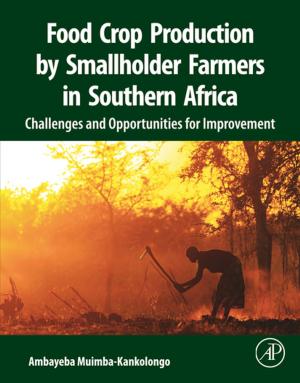Nitrogen in the Environment: Sources, Problems and Management
Nonfiction, Science & Nature, Science, Biological Sciences, Botany, Zoology| Author: | ISBN: | 9780080537566 | |
| Publisher: | Elsevier Science | Publication: | December 3, 2001 |
| Imprint: | Elsevier Science | Language: | English |
| Author: | |
| ISBN: | 9780080537566 |
| Publisher: | Elsevier Science |
| Publication: | December 3, 2001 |
| Imprint: | Elsevier Science |
| Language: | English |
Nitrogen in the Environment: Sources, Problems, and Management is the first volume to provide a holistic perspective and comprehensive treatment of nitrogen from field, to ecosystem, to treatment of urban and rural drinking water supplies, while also including a historical overview, human health impacts and policy considerations. It provides a worldwide perspective on nitrogen and agriculture.
Nitrogen is one of the most critical elements required in agricultural systems for the production of crops for feed, food and fiber. The ever-increasing world population requires increasing use of nitrogen in agriculture to supply human needs for dietary protein. Worldwide demand for nitrogen will increase as a direct response to increasing population. Strategies and perspectives are considered to improve nitrogen-use efficiency. Issues of nitrogen in crop and human nutrition, and transport and transformations along the continuum from farm field to ground water, watersheds, streams, rivers, and coastal marine environments are discussed. Described are aerial transport of nitrogen from livestock and agricultural systems and the potential for deposition and impacts. The current status of nitrogen in the environment in selected terrestrial and coastal environments and crop and forest ecosystems and development of emerging technologies to minimize nitrogen impacts on the environment are addressed. The nitrogen cycle provides a framework for assessing broad scale or even global strategies to improve nitrogen use efficiency. Growing human populations are the driving force that requires increased nitrogen inputs. These increasing inputs into the food-production system directly result in increased livestock and human-excretory nitrogen contribution into the environment.
The scope of this book is diverse, covering a range of topics and issues from furthering our understanding of nitrogen in the environment to policy considerations at both farm and national scales.
Nitrogen in the Environment: Sources, Problems, and Management is the first volume to provide a holistic perspective and comprehensive treatment of nitrogen from field, to ecosystem, to treatment of urban and rural drinking water supplies, while also including a historical overview, human health impacts and policy considerations. It provides a worldwide perspective on nitrogen and agriculture.
Nitrogen is one of the most critical elements required in agricultural systems for the production of crops for feed, food and fiber. The ever-increasing world population requires increasing use of nitrogen in agriculture to supply human needs for dietary protein. Worldwide demand for nitrogen will increase as a direct response to increasing population. Strategies and perspectives are considered to improve nitrogen-use efficiency. Issues of nitrogen in crop and human nutrition, and transport and transformations along the continuum from farm field to ground water, watersheds, streams, rivers, and coastal marine environments are discussed. Described are aerial transport of nitrogen from livestock and agricultural systems and the potential for deposition and impacts. The current status of nitrogen in the environment in selected terrestrial and coastal environments and crop and forest ecosystems and development of emerging technologies to minimize nitrogen impacts on the environment are addressed. The nitrogen cycle provides a framework for assessing broad scale or even global strategies to improve nitrogen use efficiency. Growing human populations are the driving force that requires increased nitrogen inputs. These increasing inputs into the food-production system directly result in increased livestock and human-excretory nitrogen contribution into the environment.
The scope of this book is diverse, covering a range of topics and issues from furthering our understanding of nitrogen in the environment to policy considerations at both farm and national scales.















